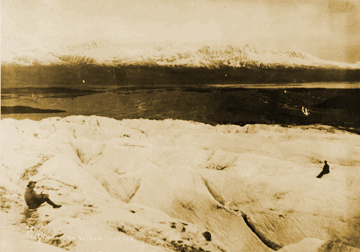 |
Writing in his diary, George Hazelet complains laconically, "It was claimed when we left Seattle that there was a wharf at this point, but if ice 18 inches thick is a wharf, then we unloaded on a wharf."
This statement shows how much the climate has warmed since 1898. Today, it is difficult to imagine ice at the head of Port Valdez thick enough for steamers to moor to or to visualize long streams of prospectors hauling their heavy equipment across the ice to the shoreline near Glacier Stream. But they did.
That is, they did until break-up. Even as the ice began to thaw, parties
raced to move their supplies and ships to depart. Margeson describes the
harrowing experience: ". . . the ice had become so rotten that large cakes
became detached, and would settle under us into the water as we passed
over them with our goods. The last half day of this work was attended with
great danger, for had any of us broken through with our loads, drowning
would have been the almost certain result."
 |
But the early arrivals were the lucky ones. Those that came after break-up had to transport their gear by longboat to shallow water, then wade across the mudflats, their feet sinking sometimes knee deep in mud, carrying or hauling their provisions ashore. No one humorously described the mudflats as a wharf.
(Read more about the gold rush in Margeson's Experiences of Gold Hunters in Alaska and the Lethcoe's Valdez Gold Rush Trails 1898-99. )